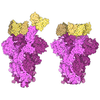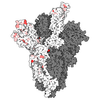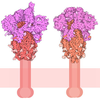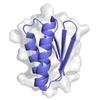[English] 日本語
 Yorodumi
Yorodumi- EMDB-23662: Complex of SARS-CoV-2 receptor binding domain with the Fab fragme... -
+ Open data
Open data
- Basic information
Basic information
| Entry | Database: EMDB / ID: EMD-23662 | |||||||||
|---|---|---|---|---|---|---|---|---|---|---|
| Title | Complex of SARS-CoV-2 receptor binding domain with the Fab fragments of neutralizing antibodies REGN10985 and REGN10989 | |||||||||
 Map data Map data | ||||||||||
 Sample Sample |
| |||||||||
 Keywords Keywords | SARS-Cov-2 / RBD / neutralizing antibody / VIRAL PROTEIN-IMMUNE SYSTEM complex | |||||||||
| Function / homology |  Function and homology information Function and homology informationMaturation of spike protein / viral translation / Translation of Structural Proteins / Virion Assembly and Release / host cell surface / host extracellular space / symbiont-mediated-mediated suppression of host tetherin activity / Induction of Cell-Cell Fusion / structural constituent of virion / entry receptor-mediated virion attachment to host cell ...Maturation of spike protein / viral translation / Translation of Structural Proteins / Virion Assembly and Release / host cell surface / host extracellular space / symbiont-mediated-mediated suppression of host tetherin activity / Induction of Cell-Cell Fusion / structural constituent of virion / entry receptor-mediated virion attachment to host cell / host cell endoplasmic reticulum-Golgi intermediate compartment membrane / membrane fusion / Attachment and Entry / positive regulation of viral entry into host cell / receptor-mediated virion attachment to host cell / host cell surface receptor binding / symbiont-mediated suppression of host innate immune response / endocytosis involved in viral entry into host cell / receptor ligand activity / fusion of virus membrane with host plasma membrane / fusion of virus membrane with host endosome membrane / viral envelope / virion attachment to host cell / SARS-CoV-2 activates/modulates innate and adaptive immune responses / host cell plasma membrane / virion membrane / identical protein binding / membrane / plasma membrane Similarity search - Function | |||||||||
| Biological species |   Homo sapiens (human) Homo sapiens (human) | |||||||||
| Method | single particle reconstruction / cryo EM / Resolution: 3.3 Å | |||||||||
 Authors Authors | Zhou Y / Romero Hernandez A | |||||||||
 Citation Citation |  Journal: Cell / Year: 2021 Journal: Cell / Year: 2021Title: The monoclonal antibody combination REGEN-COV protects against SARS-CoV-2 mutational escape in preclinical and human studies. Authors: Richard Copin / Alina Baum / Elzbieta Wloga / Kristen E Pascal / Stephanie Giordano / Benjamin O Fulton / Anbo Zhou / Nicole Negron / Kathryn Lanza / Newton Chan / Angel Coppola / Joyce Chiu ...Authors: Richard Copin / Alina Baum / Elzbieta Wloga / Kristen E Pascal / Stephanie Giordano / Benjamin O Fulton / Anbo Zhou / Nicole Negron / Kathryn Lanza / Newton Chan / Angel Coppola / Joyce Chiu / Min Ni / Yi Wei / Gurinder S Atwal / Annabel Romero Hernandez / Kei Saotome / Yi Zhou / Matthew C Franklin / Andrea T Hooper / Shane McCarthy / Sara Hamon / Jennifer D Hamilton / Hilary M Staples / Kendra Alfson / Ricardo Carrion / Shazia Ali / Thomas Norton / Selin Somersan-Karakaya / Sumathi Sivapalasingam / Gary A Herman / David M Weinreich / Leah Lipsich / Neil Stahl / Andrew J Murphy / George D Yancopoulos / Christos A Kyratsous /  Abstract: Monoclonal antibodies against SARS-CoV-2 are a clinically validated therapeutic option against COVID-19. Because rapidly emerging virus mutants are becoming the next major concern in the fight ...Monoclonal antibodies against SARS-CoV-2 are a clinically validated therapeutic option against COVID-19. Because rapidly emerging virus mutants are becoming the next major concern in the fight against the global pandemic, it is imperative that these therapeutic treatments provide coverage against circulating variants and do not contribute to development of treatment-induced emergent resistance. To this end, we investigated the sequence diversity of the spike protein and monitored emergence of virus variants in SARS-COV-2 isolates found in COVID-19 patients treated with the two-antibody combination REGEN-COV, as well as in preclinical in vitro studies using single, dual, or triple antibody combinations, and in hamster in vivo studies using REGEN-COV or single monoclonal antibody treatments. Our study demonstrates that the combination of non-competing antibodies in REGEN-COV provides protection against all current SARS-CoV-2 variants of concern/interest and also protects against emergence of new variants and their potential seeding into the population in a clinical setting. | |||||||||
| History |
|
- Structure visualization
Structure visualization
| Movie |
 Movie viewer Movie viewer |
|---|---|
| Structure viewer | EM map:  SurfView SurfView Molmil Molmil Jmol/JSmol Jmol/JSmol |
| Supplemental images |
- Downloads & links
Downloads & links
-EMDB archive
| Map data |  emd_23662.map.gz emd_23662.map.gz | 53 MB |  EMDB map data format EMDB map data format | |
|---|---|---|---|---|
| Header (meta data) |  emd-23662-v30.xml emd-23662-v30.xml emd-23662.xml emd-23662.xml | 15.1 KB 15.1 KB | Display Display |  EMDB header EMDB header |
| Images |  emd_23662.png emd_23662.png | 126.9 KB | ||
| Filedesc metadata |  emd-23662.cif.gz emd-23662.cif.gz | 6.1 KB | ||
| Archive directory |  http://ftp.pdbj.org/pub/emdb/structures/EMD-23662 http://ftp.pdbj.org/pub/emdb/structures/EMD-23662 ftp://ftp.pdbj.org/pub/emdb/structures/EMD-23662 ftp://ftp.pdbj.org/pub/emdb/structures/EMD-23662 | HTTPS FTP |
-Validation report
| Summary document |  emd_23662_validation.pdf.gz emd_23662_validation.pdf.gz | 516.1 KB | Display |  EMDB validaton report EMDB validaton report |
|---|---|---|---|---|
| Full document |  emd_23662_full_validation.pdf.gz emd_23662_full_validation.pdf.gz | 515.7 KB | Display | |
| Data in XML |  emd_23662_validation.xml.gz emd_23662_validation.xml.gz | 6.4 KB | Display | |
| Data in CIF |  emd_23662_validation.cif.gz emd_23662_validation.cif.gz | 7.4 KB | Display | |
| Arichive directory |  https://ftp.pdbj.org/pub/emdb/validation_reports/EMD-23662 https://ftp.pdbj.org/pub/emdb/validation_reports/EMD-23662 ftp://ftp.pdbj.org/pub/emdb/validation_reports/EMD-23662 ftp://ftp.pdbj.org/pub/emdb/validation_reports/EMD-23662 | HTTPS FTP |
-Related structure data
| Related structure data |  7m42MC M: atomic model generated by this map C: citing same article ( |
|---|---|
| Similar structure data |
- Links
Links
| EMDB pages |  EMDB (EBI/PDBe) / EMDB (EBI/PDBe) /  EMDataResource EMDataResource |
|---|---|
| Related items in Molecule of the Month |
- Map
Map
| File |  Download / File: emd_23662.map.gz / Format: CCP4 / Size: 103 MB / Type: IMAGE STORED AS FLOATING POINT NUMBER (4 BYTES) Download / File: emd_23662.map.gz / Format: CCP4 / Size: 103 MB / Type: IMAGE STORED AS FLOATING POINT NUMBER (4 BYTES) | ||||||||||||||||||||||||||||||||||||||||||||||||||||||||||||||||||||
|---|---|---|---|---|---|---|---|---|---|---|---|---|---|---|---|---|---|---|---|---|---|---|---|---|---|---|---|---|---|---|---|---|---|---|---|---|---|---|---|---|---|---|---|---|---|---|---|---|---|---|---|---|---|---|---|---|---|---|---|---|---|---|---|---|---|---|---|---|---|
| Projections & slices | Image control
Images are generated by Spider. | ||||||||||||||||||||||||||||||||||||||||||||||||||||||||||||||||||||
| Voxel size | X=Y=Z: 0.85 Å | ||||||||||||||||||||||||||||||||||||||||||||||||||||||||||||||||||||
| Density |
| ||||||||||||||||||||||||||||||||||||||||||||||||||||||||||||||||||||
| Symmetry | Space group: 1 | ||||||||||||||||||||||||||||||||||||||||||||||||||||||||||||||||||||
| Details | EMDB XML:
CCP4 map header:
| ||||||||||||||||||||||||||||||||||||||||||||||||||||||||||||||||||||
-Supplemental data
- Sample components
Sample components
-Entire : Complex of SARS-CoV-2 receptor binding domain with the Fab fragme...
| Entire | Name: Complex of SARS-CoV-2 receptor binding domain with the Fab fragments of neutralizing antibodies REGN10985 and REGN10989 |
|---|---|
| Components |
|
-Supramolecule #1: Complex of SARS-CoV-2 receptor binding domain with the Fab fragme...
| Supramolecule | Name: Complex of SARS-CoV-2 receptor binding domain with the Fab fragments of neutralizing antibodies REGN10985 and REGN10989 type: complex / ID: 1 / Parent: 0 / Macromolecule list: all |
|---|---|
| Source (natural) | Organism:  |
-Macromolecule #1: REGN10989 antibody Fab fragment light chain
| Macromolecule | Name: REGN10989 antibody Fab fragment light chain / type: protein_or_peptide / ID: 1 / Number of copies: 1 / Enantiomer: LEVO |
|---|---|
| Source (natural) | Organism:  Homo sapiens (human) Homo sapiens (human) |
| Molecular weight | Theoretical: 22.709975 KDa |
| Recombinant expression | Organism:  |
| Sequence | String: QSALTQPASV SGSPGQSITI SCTGTSSDVG TYNYVSWYQQ HPGKAPKLMI FDVSNRPSGV SDRFSGSKSG NTASLTISGL QAEDEADYY CSSFTTSSTV VFGGGTKLTV LGQPKAAPSV TLFPPSSEEL QANKATLVCL ISDFYPGAVT VAWKADSSPV K AGVETTTP ...String: QSALTQPASV SGSPGQSITI SCTGTSSDVG TYNYVSWYQQ HPGKAPKLMI FDVSNRPSGV SDRFSGSKSG NTASLTISGL QAEDEADYY CSSFTTSSTV VFGGGTKLTV LGQPKAAPSV TLFPPSSEEL QANKATLVCL ISDFYPGAVT VAWKADSSPV K AGVETTTP SKQSNNKYAA SSYLSLTPEQ WKSHRSYSCQ VTHEGSTVEK TVAPTECS |
-Macromolecule #2: REGN10989 antibody Fab fragment heavy chain
| Macromolecule | Name: REGN10989 antibody Fab fragment heavy chain / type: protein_or_peptide / ID: 2 / Number of copies: 1 / Enantiomer: LEVO |
|---|---|
| Source (natural) | Organism:  Homo sapiens (human) Homo sapiens (human) |
| Molecular weight | Theoretical: 24.815834 KDa |
| Recombinant expression | Organism:  |
| Sequence | String: QVQLVQSGAE VKKPGASVKV SCKASGYIFT GYYMHWVRQA PGQGLEWMGW INPNSGGANY AQKFQGRVTL TRDTSITTVY MELSRLRFD DTAVYYCARG SRYDWNQNNW FDPWGQGTLV TVSSASTKGP SVFPLAPSSK STSGGTAALG CLVKDYFPEP V TVSWNSGA ...String: QVQLVQSGAE VKKPGASVKV SCKASGYIFT GYYMHWVRQA PGQGLEWMGW INPNSGGANY AQKFQGRVTL TRDTSITTVY MELSRLRFD DTAVYYCARG SRYDWNQNNW FDPWGQGTLV TVSSASTKGP SVFPLAPSSK STSGGTAALG CLVKDYFPEP V TVSWNSGA LTSGVHTFPA VLQSSGLYSL SSVVTVPSSS LGTQTYICNV NHKPSNTKVD KKVEPKSCDK T |
-Macromolecule #3: Spike protein S1
| Macromolecule | Name: Spike protein S1 / type: protein_or_peptide / ID: 3 / Number of copies: 1 / Enantiomer: LEVO |
|---|---|
| Source (natural) | Organism:  |
| Molecular weight | Theoretical: 28.437902 KDa |
| Recombinant expression | Organism:  |
| Sequence | String: RVQPTESIVR FPNITNLCPF GEVFNATRFA SVYAWNRKRI SNCVADYSVL YNSASFSTFK CYGVSPTKLN DLCFTNVYAD SFVIRGDEV RQIAPGQTGK IADYNYKLPD DFTGCVIAWN SNNLDSKVGG NYNYLYRLFR KSNLKPFERD ISTEIYQAGS T PCNGVEGF ...String: RVQPTESIVR FPNITNLCPF GEVFNATRFA SVYAWNRKRI SNCVADYSVL YNSASFSTFK CYGVSPTKLN DLCFTNVYAD SFVIRGDEV RQIAPGQTGK IADYNYKLPD DFTGCVIAWN SNNLDSKVGG NYNYLYRLFR KSNLKPFERD ISTEIYQAGS T PCNGVEGF NCYFPLQSYG FQPTNGVGYQ PYRVVVLSFE LLHAPATVCG PKKSTNLVKN KCVNFEQKLI SEEDLGGEQK LI SEEDLHH HHHH UniProtKB: Spike glycoprotein |
-Macromolecule #4: REGN10985 antibody Fab fragment light chain
| Macromolecule | Name: REGN10985 antibody Fab fragment light chain / type: protein_or_peptide / ID: 4 / Number of copies: 1 / Enantiomer: LEVO |
|---|---|
| Source (natural) | Organism:  Homo sapiens (human) Homo sapiens (human) |
| Molecular weight | Theoretical: 22.89518 KDa |
| Recombinant expression | Organism:  |
| Sequence | String: QSVLTQPPSV SGAPGQRVTI SCTGSSSNIG AGYDVHWYQQ LPGTAPKLLI YGNSNRPSGV PDRFSGSKSG TSASLAITGL QAEDEADYY CQSYDSSLSG SYVFGTGTKV TVLGQPKAAP SVTLFPPSSE ELQANKATLV CLISDFYPGA VTVAWKADSS P VKAGVETT ...String: QSVLTQPPSV SGAPGQRVTI SCTGSSSNIG AGYDVHWYQQ LPGTAPKLLI YGNSNRPSGV PDRFSGSKSG TSASLAITGL QAEDEADYY CQSYDSSLSG SYVFGTGTKV TVLGQPKAAP SVTLFPPSSE ELQANKATLV CLISDFYPGA VTVAWKADSS P VKAGVETT TPSKQSNNKY AASSYLSLTP EQWKSHRSYS CQVTHEGSTV EKTVAPTECS |
-Macromolecule #5: REGN10985 antibody Fab fragment heavy chain
| Macromolecule | Name: REGN10985 antibody Fab fragment heavy chain / type: protein_or_peptide / ID: 5 / Number of copies: 1 / Enantiomer: LEVO |
|---|---|
| Source (natural) | Organism:  Homo sapiens (human) Homo sapiens (human) |
| Molecular weight | Theoretical: 24.857811 KDa |
| Recombinant expression | Organism:  |
| Sequence | String: EVQLVESGGG LVQPGRSLRL SCAASGFTFD DYAMHWVRQA PGKGLEWVSG ISWNRGSIGY ADSVKGRFTI SRDNAKNSLY LQMSSLRAE DTALYYCAKD GERWDSVVVP SARNGMDVWG QGTTVTVSSA STKGPSVFPL APSSKSTSGG TAALGCLVKD Y FPEPVTVS ...String: EVQLVESGGG LVQPGRSLRL SCAASGFTFD DYAMHWVRQA PGKGLEWVSG ISWNRGSIGY ADSVKGRFTI SRDNAKNSLY LQMSSLRAE DTALYYCAKD GERWDSVVVP SARNGMDVWG QGTTVTVSSA STKGPSVFPL APSSKSTSGG TAALGCLVKD Y FPEPVTVS WNSGALTSGV HTFPAVLQSS GLYSLSSVVT VPSSSLGTQT YICNVNHKPS NTKVDKKVEP KSCDKT |
-Experimental details
-Structure determination
| Method | cryo EM |
|---|---|
 Processing Processing | single particle reconstruction |
| Aggregation state | particle |
- Sample preparation
Sample preparation
| Buffer | pH: 7.5 |
|---|---|
| Vitrification | Cryogen name: ETHANE |
- Electron microscopy
Electron microscopy
| Microscope | FEI TITAN KRIOS |
|---|---|
| Image recording | Film or detector model: GATAN K3 BIOQUANTUM (6k x 4k) / Average electron dose: 40.0 e/Å2 |
| Electron beam | Acceleration voltage: 300 kV / Electron source:  FIELD EMISSION GUN FIELD EMISSION GUN |
| Electron optics | Illumination mode: FLOOD BEAM / Imaging mode: BRIGHT FIELD |
| Experimental equipment |  Model: Titan Krios / Image courtesy: FEI Company |
- Image processing
Image processing
| Startup model | Type of model: NONE |
|---|---|
| Final reconstruction | Resolution.type: BY AUTHOR / Resolution: 3.3 Å / Resolution method: FSC 0.143 CUT-OFF / Number images used: 146054 |
| Initial angle assignment | Type: RANDOM ASSIGNMENT |
| Final angle assignment | Type: MAXIMUM LIKELIHOOD |
 Movie
Movie Controller
Controller















 Z (Sec.)
Z (Sec.) Y (Row.)
Y (Row.) X (Col.)
X (Col.)





















